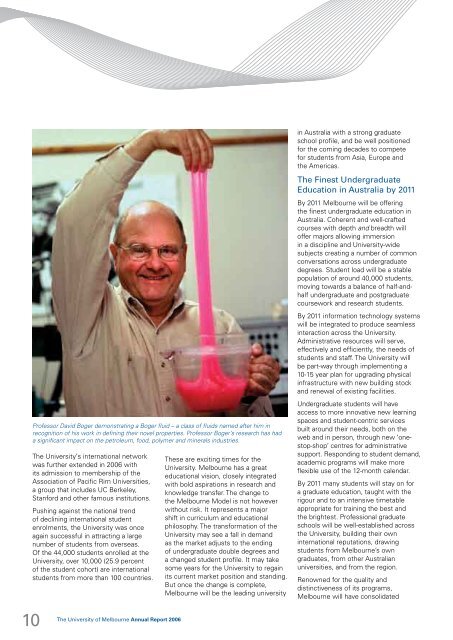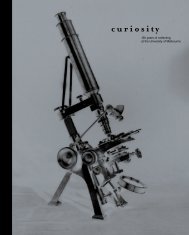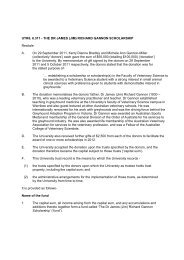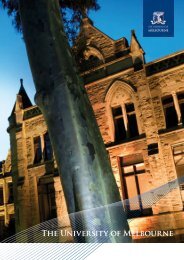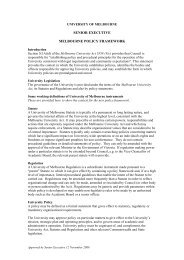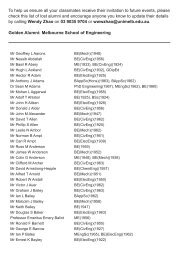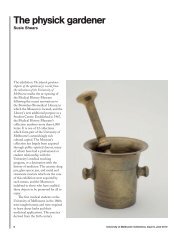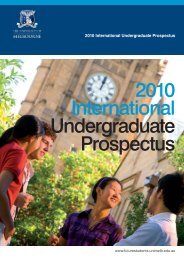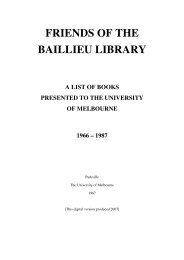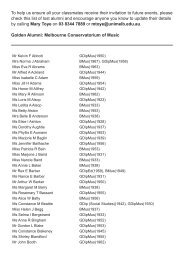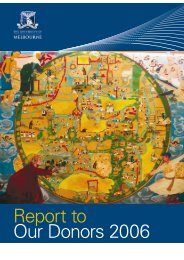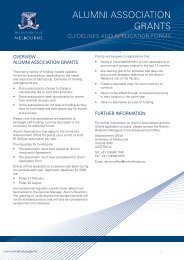annual report/2006 - University of Melbourne
annual report/2006 - University of Melbourne
annual report/2006 - University of Melbourne
You also want an ePaper? Increase the reach of your titles
YUMPU automatically turns print PDFs into web optimized ePapers that Google loves.
10<br />
Pr<strong>of</strong>essor David Boger demonstrating a Boger fluid – a class <strong>of</strong> fluids named after him in<br />
recognition <strong>of</strong> his work in defining their novel properties. Pr<strong>of</strong>essor Boger’s research has had<br />
a significant impact on the petroleum, food, polymer and minerals industries.<br />
The <strong>University</strong>’s international network<br />
was further extended in <strong>2006</strong> with<br />
its admission to membership <strong>of</strong> the<br />
Association <strong>of</strong> Pacific Rim Universities,<br />
a group that includes UC Berkeley,<br />
Stanford and other famous institutions.<br />
Pushing against the national trend<br />
<strong>of</strong> declining international student<br />
enrolments, the <strong>University</strong> was once<br />
again successful in attracting a large<br />
number <strong>of</strong> students from overseas.<br />
Of the 44,000 students enrolled at the<br />
<strong>University</strong>, over 10,000 (25.9 percent<br />
<strong>of</strong> the student cohort) are international<br />
students from more than 100 countries.<br />
The <strong>University</strong> <strong>of</strong> <strong>Melbourne</strong> Annual Report <strong>2006</strong><br />
These are exciting times for the<br />
<strong>University</strong>. <strong>Melbourne</strong> has a great<br />
educational vision, closely integrated<br />
with bold aspirations in research and<br />
knowledge transfer. The change to<br />
the <strong>Melbourne</strong> Model is not however<br />
without risk. It represents a major<br />
shift in curriculum and educational<br />
philosophy. The transformation <strong>of</strong> the<br />
<strong>University</strong> may see a fall in demand<br />
as the market adjusts to the ending<br />
<strong>of</strong> undergraduate double degrees and<br />
a changed student pr<strong>of</strong>ile. It may take<br />
some years for the <strong>University</strong> to regain<br />
its current market position and standing.<br />
But once the change is complete,<br />
<strong>Melbourne</strong> will be the leading university<br />
in Australia with a strong graduate<br />
school pr<strong>of</strong>ile, and be well positioned<br />
for the coming decades to compete<br />
for students from Asia, Europe and<br />
the Americas.<br />
The Finest Undergraduate<br />
Education in Australia by 2011<br />
By 2011 <strong>Melbourne</strong> will be <strong>of</strong>fering<br />
the finest undergraduate education in<br />
Australia. Coherent and well-crafted<br />
courses with depth and breadth will<br />
<strong>of</strong>fer majors allowing immersion<br />
in a discipline and <strong>University</strong>-wide<br />
subjects creating a number <strong>of</strong> common<br />
conversations across undergraduate<br />
degrees. Student load will be a stable<br />
population <strong>of</strong> around 40,000 students,<br />
moving towards a balance <strong>of</strong> half-andhalf<br />
undergraduate and postgraduate<br />
coursework and research students.<br />
By 2011 information technology systems<br />
will be integrated to produce seamless<br />
interaction across the <strong>University</strong>.<br />
Administrative resources will serve,<br />
effectively and efficiently, the needs <strong>of</strong><br />
students and staff. The <strong>University</strong> will<br />
be part-way through implementing a<br />
10-15 year plan for upgrading physical<br />
infrastructure with new building stock<br />
and renewal <strong>of</strong> existing facilities.<br />
Undergraduate students will have<br />
access to more innovative new learning<br />
spaces and student-centric services<br />
built around their needs, both on the<br />
web and in person, through new ‘onestop-shop’<br />
centres for administrative<br />
support. Responding to student demand,<br />
academic programs will make more<br />
flexible use <strong>of</strong> the 12-month calendar.<br />
By 2011 many students will stay on for<br />
a graduate education, taught with the<br />
rigour and to an intensive timetable<br />
appropriate for training the best and<br />
the brightest. Pr<strong>of</strong>essional graduate<br />
schools will be well-established across<br />
the <strong>University</strong>, building their own<br />
international reputations, drawing<br />
students from <strong>Melbourne</strong>’s own<br />
graduates, from other Australian<br />
universities, and from the region.<br />
Renowned for the quality and<br />
distinctiveness <strong>of</strong> its programs,<br />
<strong>Melbourne</strong> will have consolidated


